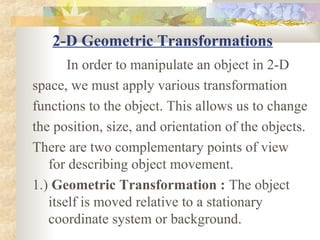
2 d geometric transformations
- 1. 2-D Geometric Transformations In order to manipulate an object in 2-D space, we must apply various transformation functions to the object. This allows us to change the position, size, and orientation of the objects. There are two complementary points of view for describing object movement. 1.) Geometric Transformation : The object itself is moved relative to a stationary coordinate system or background.
- 2. 2.) Coordinate transformation : The object is held stationary while the coordinate system is moved relative to the object. The Basic geometric transformations are: Translation Rotation Scaling Reflection Shear
- 3. Translation Moving an object is called a translation. We translate point by moving to the x and y coordinates, the amount the point should be shifted in the x and y directions. We translate an object by translating each vertex in the object. x’ = x + tx y’ = y + ty
- 5. The translating distance pair( tx, ty) is called a translation vector or shift vector. We can also write this equation in a single Matrix using column vectors: P = x1 P’ = x1’ T = tx x2 x2’ ty or, P’ = P + T That is, every point on the object is translated by the same amount.
- 6. Rotation An object can be rotated about the origin by a specific rotation angle θ & the position (xr,yr) of the rotation point about which the object is to be rotated. Positive values for the rotation angle define counterclockwise rotations & -ve defines clockwise direction. This transformation can also be described as a rotation about the rotation axis that is perpendicular to the xy plane.
- 7. θ Φ
- 8. In the fig., r is the constant distance of the point from the origin, angle Φ is the original angular position of the point from the horizontal, & θ is the rotation angle. We can express the coordinates as: x2 = r cos(Φ+θ) = r cosΦ cosθ – r sinΦ sinθ y2 = r sin(Φ+θ) = r cosΦ sinθ + r sinΦ cosθ The original coordinates of the points in the polar coordinates are x = r cosΦ , y = r sinΦ
- 9. We obtain the transformation equations for rotating a point (x,y) through an angle θ about the origin is: x2 = x cos θ – y sin θ y2 = x sin θ + y cos θ We can write the rotation equations in the matrix form: P’ = R . P & the rotation matrix is R = cos θ -sin θ sin θ cos θ
- 10. Scaling Changing the size of an object is called Scaling . We scale an object by scaling the x and y coordinates of each vertex in the object.
- 11. Positive scaling constraints sx & sy which are the scaling factors are used to produce the transformed coordinates (x’, y’). x’ = x . sx , y’ = y . sy Scaling factor sx scales objects in the x direction, while sy scales objects in the y direction. The transformation equations can be written in the matrix form: x’ = sx 0 . x y’ = 0 sy y
- 12. or P’ = S . P There are three scaling factors: (i) A scaling constant > 1 indicates expansion of length ie. Magnification (ii) A scaling constant < 1 indicates compression of length ie. reduction (iii) A scaling constant = 1 leaves the size of object unchanged. When assigned the same value, a uniform scaling is produced & for unequal values differential scaling is produced.
- 13. Reflection A reflection is a transformation that produces a mirror image of an object. Since the reflection P’ of an object point P is located the same distance from the mirror as P. (i) The mirror reflection transformation Mx about the x-axis is given by: P’ = Mx (P) where, x’ = x & y’ = -y It can be represented in matrix form as:
- 14. P’ = x’ Mx = 1 0 P= x y’ 0 -1 y y P’(-x, y) P(x, y) x P’(x, -y)
- 15. (ii) The mirror reflection transformation My about y-axis is given by: P’ = My(P) where, x’ = -x & y’ = y It can be represented in matrix form as: P’ = x’ My = -1 0 P= x y’ 0 1 y
- 16. Shear The shear transformation distorts an object by scaling one coordinate using the other Original Data Y Shear X Shear
- 17. An x-direction shear relative to the x axis is produced with the transformation matrix 1 Shx 0 1 which transforms coordinate position as x’ = x + Shx . y , y’ = y Similarly, a y-direction shear relative to the y axis is produced with the transformation matrix
- 18. 1 0 Shy 1 which transforms coordinate position as y’ = x . Shy + y , x’ = x Example: Take (x,y) = (1,1) & Shx = 2 X’ = x + Shx . Y y’ = y =1+2.1 y’ = 1 =1+2 =3 (x’, y’) = (3,1)
- 19. 0,1 1,1 0,0 1,0 2,1 3,1 0,0 1,0
- 20. Inverse Geometric Transformations Each geometric transformation has an inverse which is described by the opposite operation performed by the transformation: Translation: Tv-1 = T-v, translation in opposite direction Rotation: Rθ-1 = R-θ, rotation in opposite direction Scaling: Ssx,sy-1 = S1/sx,1/sy Reflection: Mx-1 = Mx & My-1 = My
